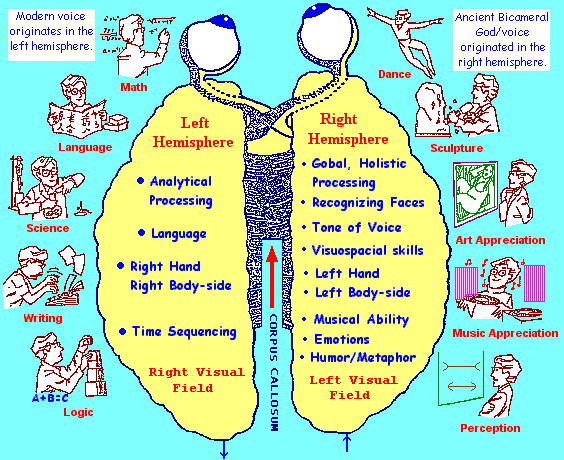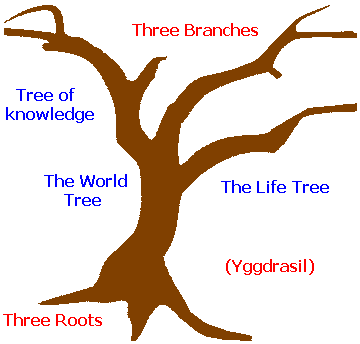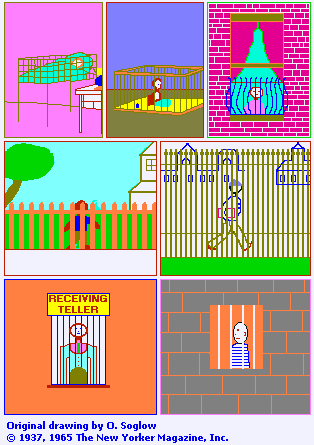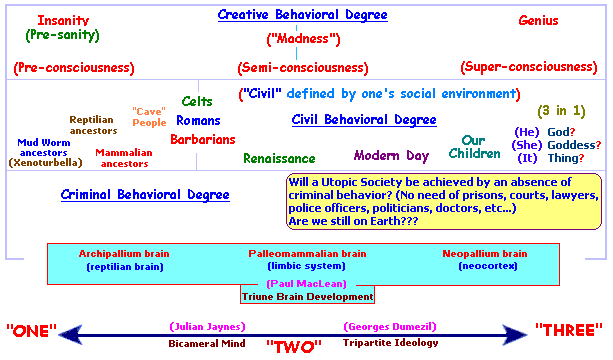 |
Buckland's Third Revolution Poster 7th Column |
 |
(Threesology Research Journal)
http://threesology.org
| BTR column 1 | BTR column 2 | BTR column 3 | BTR column 4 | BTR column 5 | BTR column 6 | BTR column 7 | BTR column 8 | Images of posters |
Visitors as of March 28th 2024
*** From the Brihadaranyaka Upanishad, translated by E Max Muller: Then Vidagdha Saklaya asked him: "How many gods are there, 0 Yajnavalkya?" He replied with this very Nivid (Sanskrit: "saying"): "As many as are mentioned in the Nivid of the hymn of praise addressed to the Visvedevas,... three and three hundred, three and three thousand. (The same question is asked five more times and the following quantity of gods is given, separately, thirty-three, six, three, two, one.)
*** The Islamic tradition (Koran 74.8) relates that God created a special angel Israfil whose task it is to hold the trumpet to his mouth without sleeping, century after century, until God gives him the sign to blow. The first blast will destroy all buildings on Earth and all people will die. The mountains will collapse, the seas will dry up, the stars will fall down. The second blast, forty years later, will raise the prophet Muhammad. On the third blast all people will rise, having received new bodies.

| Left
Hemisphere Neo-Mammalian (Predominantly 3-patterned) Math: Associative Commutative Distributive Logic: Major Premise Minor Premise Conclusion Time Sequencing: Seconds - Past Minutes - Present Hours - future Language: Subject Object Verb Right Body Side: Tri-cuspid heart valve Three-lobed lung |
 Limbic System Reptilian Predominantly 1-patterned) (Self)-Preservation (Self)-Procreation (Self)-Preeminence |
Right
Hemisphere Mammalian (Predominantly 2-patterned) Holistic: (viewing the whole) Macro versus Micro Whole versus Part Music: Major Scale vs Minor Scale Loud versus Soft Visuospatial: (Art) Background vs Foreground Light vs Dark (Contrasts) 1 Dimension vs 2 Dimensions Emotions: Pain versus Pleasure Positive vs Negative Left Body Side: Bi-cuspid heart valve Two-lobed lung |
| Note: When we use the left hemisphere attribute
"analysis" to define qualities of the right hemisphere, we often-times
assign an additional third criteria in one form or another. When we use
the right hemisphere attribute 'viewing' (recognizing) to define qualities
of the left hemisphere, we often-times alter the 3-part descriptions into
2-part 'portraits'. For example, (generally speaking): Left "analyzing" Right: Holistic may acquire the additional term "Synergy" or "Unity"; Music can develop a Triadic structure; Art acquires a 3rd dimension and 3-color (trichromatic) theory; Emotion is assigned words such as Compassion, Patience, and Empathy. Right "viewing" Left: Math may he seen as Give & Take; Logic may become a Mind/Body dichotomy; Time is related to Life & Death; Language is perceived as High & Low pitch. Left "analyzing" Reptilian attributes may develop three criteria which distinguish a (3 in 1) singular nature, such as arousal, motivation, and emotion. Right "viewing" Reptilian attributes may picture the basic drives as the seat of emotion whereby a type of kinship alliance is formulated in order to maintain the idea of a dual brain by not permitting the "Reptilian Brain" a separate entity status. Additionally, we find (impulsively) rendered attempts to define the "whole" (as yet only) human brain as an inherently polarized structure by those "portraying" various 2-part (opposite) descriptions. (Recall 'whole' & 'impulsive' are attributes of the Right Hemisphere.) The sample list is a 2-patterned holistic (gestalt) appraisal of the human brain which actually proceeds along a 1-2-3 maturational sequence, but this is not to imply that the entire sequence is always achieved. Not all individuals reach each successive stage at the same time, in the same manner, or completely. |
| Who Proposed It | Left Hemisphere | Right Hemisphere |
| Many Sources | Rational | Irrational |
| " | Analytical | Creative (Artistic) |
| " | Deliberate | Impulsive |
| " | Verbal | Non-Verbal |
| " | Public Knowledge | Private Knowledge |
| " | Literal Meaning | Metaphorical Meaning |
| " | Intellect | Intuition |
| " | Digital | Analogic |
| " | Abstract | Concrete |
| " | Lineal | Non-Lineal |
| " | Objective | Subjective |
| I Ching | The Creative: Heaven | The Receptive: Earth |
| " | Yang, Masculine | Yin, Feminine |
| " | Light, Day, Sun | Night, Dark, Moon |
| " | Spring, Summer | Autumn, Winter |
| " | Reason, Cold | Emotion, Warm |
| " | Aggressive | Yielding |
| " | Positive | Negative |
| Freud | Secondary Process | Primary Process |
| Piaget | Primary Symbolism | Secondary Symbolism |
| Schactel | Accommodation | Assimilation |
| Maslow | A Cognition | B Cognition |
| Taylor | Convergent Thinking | Divergent Thinking |
| Polanyi | Explicit | Tacit |
| Bogen | Propositional | Oppositional |
| Wertheimer | Productive Thinking | Blind Thinking |
| Bleuler | Realistic Thinking | Autistic Thinking |
| Domhoff | Right (side of body) | Left (side of body) |
| Luria | Sequential (Successive) | Simultaneous (Multiple) |
| Kubie | Conscious Processing | Pre-(Un)-conscious Processing |
| Langer | Discursive Symbolism | Presentational Symbolization |
| Oppenheimer | Time, History | Eternity, Timelessness (Space) |
*** In aggressive Sociopaths, EA. Elliot (1979) concludes that their EEG waves are of the Delta and Theta variety which are typical of children and not adults. For same, this gives credence to the idea that criminals, for the most part and in general, for whatever reason, are in varying degrees slower in the maturational developmental processes. However, please do not misconstrue this observation. In some individuals, an increased theta wave activity does not bring deeply buried unconscious problems to the surface to be expressed in destructive ways; it helps them to acknowledge and make use of valuable archetypal images which are then represented in a variety of art forms and activities, as well as inspiring other creative, innovative, and original ideas that can he applied for social good. Looking at the developmental processes of the brain we witness a transition from the Limbic system (Reptilian brain) to the Right hemisphere than to the left Hemisphere which is considered to be a counter-clockwise direction. This right-to-left direction also is the same direction that most amino acids are said to be in with the more common reference of "left handedness," "levorotary," or less commonly, chirality.
If criminal activity is an expression of an individual who is "stuck" or in transition with respect to what might be called a "Terrible Two's" developmental orientation, our methods of prevention, intervention, and rehabilitation must accommodate the realization that each individual passes through a 1-patterned, 2-patterned, and 3-patterned world view under normal circumstances given ideal genetic, nutritional, and environmental conditions. Educators also must realize that beyond the "3" is the 3 to 1 ratio view that some students are no doubt experiencing but hove no social reference for except in eclectic approximations which present themselves in abstruse and esoteric ways as to be misinterpreted as weird, strange, alien, crazy, insane, otherworldly, inter-dimensional, bizarre, eccentric, evil, youth-created-fictions, drug induced, or even genius.
*** Compare the foregoing list of two-patterned views with common references to mental ailments and appreciate that they too are (antiquated) "portraits" of the right hemisphere: Schizophrenia (Eugene Bleuler, 1857-1939): "splitting of the mind" (The word ambivalence is used to describe "contradictory" manifestations of impulse, idea, or effect. Bipolar (Emil Kraeplin, 1856-1926): "cyclical manic/depressive behavior" (I once worked with an individual who said he was told (by those medical "gods" wearing white coats) that he had a bipolar disorder. I suggested he move into a "tripolor" frame of mind so as not to be chained down by the idiocy of present-day (two patterned) witch-doctor treatment views. It took him awhile to rid himself of the learned dependency that many doctors actively encourage patients to have, whereby they retain manipulative control (and can thus afford to buy excessive social luxuries.) Nonetheless, he freed himself of their (two-patterned) bipolar nonsense and is much happier!) Passive/Aggressive, Obsessive/Compulsive, Introverted/Extroverted, etc., though often fused together to represent a singular personality type, also are old fashioned right hemispheric "portraits."
*** We have Unipolar disorder and Bipolar disorder but no mention of a Tripolar condition whether good or bad. Even though individuals with a Bipolar disorder are encouraged to attempt self-monitoring for the purpose of recognizing the tell-tale signs of mood-swing change in order to alleviate circumstances which might produce dire consequences, the central idea of maintaining equilibrium should be called Tripolar as a means of enhancing understanding the 1-2-3 maturationally developing psychological processes because the similarity of labeling would advantage both the patient and physician in obtaining corrective results. An easily identifiable cognitive grouping formula will surely enhance understanding and lessen the stagnating preoccupation with the outdated notion of two extremes.
*** The ambivalent ("contradictory" or "bipartite") ideas such as good/evil, immortal (gods)/ mortal (humans), etc., with all the connotative embellishments given them by early humans, suggests our early ancestors were all schizophrenic due to the widespread usage of such ideas. (Humorously speaking, it means we all have a "crazy" gene in us.)
*** From pages 6 & 7 of the book "The Psyche and Schizophrenia," by Luc Ciampi, 1988, we find: "The overall structure of the psychoanalytic theory of drives-as of psychoanalytic theory in general-is dualistic or polar. Mental states, and drive states in particular, are regarded as the continually fluctuating results of dynamic processes occurring within a field of numerous poles or pairs of opposites. The most important of these are Conscious/Unconscious; Love/Hate; Life instincts (libido)/ Death instincts (destrudo); Object libido (object love or hate)/Ego libido (narcissistic libido-self love or hate); Pleasure principle/Reality principle; Tension/Relaxation; Stability principle/Nirvana principle . . . although various pairs overlap and the categories listed may not correspond directly. Bipolarities represent the simplest possible form of a "system"-a fact whose general significance has not been sufficiently recognized. More complex systems arise when several bipolarities interact. These bipolar structures, most especially the "stability principle" and "Nirvana principle," which Freud took over from Gustav Fechner and Barbara Low, correspond exactly to the concepts of homeostasis and entropy." . . .
Yet on page 160 he uses a three patterned orientation: "no one to my knowledge has yet integrated the approaches of (1) Systems Theory (2) Family Dynamics, and (3) Psychoanalysis into one unified theory of schizophrenia that would relate intrapsychic and interpersonal processes in the way in which they must obviously be connected in reality." (This is another 3 in 1 Unified Theory idea similar to other 3 in 1 Unified Theories being proposed in other disciplines.
Don't you think it's about time for all of human society to acknowledge such a "threes" orientation as being a fundamental human cognition process and this is why it's cropping up in various human endeavors?!! Don'/ wake up by smelling the coffee, tobacco, or imitation mountain-air incense, wake up by opening your eyes without the use of aromatic drugs that are being sold by companies that could care less if you live or die, that is after you buy one of their products.) Doctor Ciampi further states: "I am convinced that every new insight into "the nature of the beast" will prove to be practically useful in the long run"...
On page 181, he states: The psyche is thus truly "healthy" and in equilibrium-that is, capable of (1) optimal functioning (2) adoption, and (3) development-when it steers a middle course, and when shifts from one system of reference to another are moderate in (1) flexibility (2) amplitude, and (3) speed. In this case, the "middle" is the element one needs to progress to." (Put his comments in a 3-dimensional illustration and you will see the recurring triangular image though a 2-dimensional perspective often cites such as circular.)
On page 188, he mentions his three schizophrenic process phases: (1) The premorbid (from birth until the outbreak of the disease) (2) Acute psychosis (3) Chronic. (Once again we find another "expert" using a pattern-of-three idea (described with discipline-specific labels) as a basis for dealing with "traditional" pattern-of-two formulations instead of coming to the realization that there exists a 1-2-3 maturational evolutionary development taking place with the human species.
The point to be made is that we all recognize the existence of patterns-of-two, but some theorists are taking this everyday recognition too literally whereby entire schools (of academic-trained perception) teach this (child's) world-view as if it were the singular fundamental makeup of the psychological processes. They fail to recognize their own intuitive acknowledgment that patterns-of-two are part of a 1-23 maturational development sequence, whereby the labels they attach to their perceptions of patterns-of-two are being used to (inclusively) demark assumed beginning and ending boundaries which obscure the appreciation of a developmental third participant. Simply put, life on planet Earth is a dynamic evolutionary process where the appearance of opposites (patterns-of-two) precede the appearance of the third counterpart, but the slow rate of human recognition (due partly to the delimiting descriptive labels employed), of the third element in the process creates a condition of static thinking in those who persist in the ludicrous argument that patterns-of-two can explain the totality of developmental processes. (Or if not the totality, the main part, which is another asinine remark meant to deflect your attention from further articulation of their atavistic logic.) Theirs is an archaic form of thinking.
 |
This sequence of drawings show
(using a Dichotomous analysis) that it is absurd to consider that a person
can become the victim of their biography. However, using a Trichotomous
analysis approach which recognizes a 1-2-3 maturational development
sequence, these drawings do in fact illustrate the mindset of an individual
with a predominant two-patterned perspective of polarized views:
Inside/Outside; In front of bars/Behind bars; Here/There; etc... A
three-patterned predominant individual can have similar social experiences
but choose to visualize an alternative path. In other words, with this
rendering, a new school of Psychology has just been born. Another example of some people viewing their world in a particular (but not necessarily predominant) polarized fashion is illustrated by the following "Language and Sexism" comparison: A businessman is aggressive, a businesswoman is pushy. A businessman is good on details, she's picky; He follows through, she doesn't know when to quit. He stands firm, she's hard. His judgments are her prejudices. He is a man of the world, she's been around. He isn't afraid to say what is on his mind, she's mouthy. He exercises authority diligently, she's power mad. He's closed mouthed, she's secretive. He climbed the ladder of success, she slept her way to the top. (Graduate School of Management, UCLA, The Balloon, vol xxiii, no. 6) |
*** To help in your understanding of the aforementioned "New School of Psychology," the diagram below is a generalized portrayal of the overlaps occurring in human behavior with respect to criminal, civil, and creative activities. In relative terms we can make some assessment of what is meant by being criminal or civil, but what is meant by being creative is another matter. Thus I exhibit the "Creative Behavioral Degree" as being quite broad with an acknowledged line to indicate the colloquial notion of there being a fine line between genius and insanity, both of which are other vague terms applied to creativity. The underlying designations of 'one', 'two', and 'three' in concert with an arrow, show that we, as a species, have not arrived at a complete "3" state, whatever this may mean in terms of our future development aside from the usual metaphysical (annotations. Such an "advanced" individual would no doubt appear 'different,' if not physically, then their ideas might be looked upon as criminal instead of as creative, innovative, and original. Most of us are still in a partial "2"-going-on-to-"3" transition, while some of us are predominantly in a "2" stage of cognitive orientation herein represented by criminal behavior.

Some criminals are creative, some civil, while others are viewed as being no different than a reptilian minded beast of prey. There are various over-lappings amongst these three behavior groups similar to the over-lappings encountered when observing the successive 1-2-3 grouping stages of babbling that overlap prior to and during the (overlapping) 1-2-3 grouping stages of word usage development. Individualized frequency of overlap as well as intermittent (progressive or regressive) uses of any of these stages vary with the circumstances experienced by the infant and child. "Regression" in this context, is a term used to describe the exhibition of a behavior consistent with an earlier stage of development. With respect to infants, children, adolescents, and psycho-pathological disturbances in general, we sometimes accept the notion that such uses of early behaviors are temporary, that they will grow out of them.
Obviously, with respect to a 1-2-3 maturational development sequence, a predominant usage of patterns-of-two (with little or no referenced usages to patterns-of-three), is not necessarily a temporary stage of regression that an individual can 'grow out of as can be indicated by the usage of two-patterned orientations of three-time losing criminals. The idea of criminals being "throwbacks" to an earlier type of human is an interesting but misleading consideration meant to describe why a seemingly "normal" person would "all of a sudden" commit a crime. Two-pattern oriented individuals can appear quite "normal" until confronted with a three-patterned situation that they cannot progress into. It is easier for a three-pattern oriented individual to "regress" to a two patterned circumstance, as well as manipulate two-patterned individuals into maintaining a two-patterned environment which they control for selfish interests.
3 part Edward O. Wilson's Sociobiology definition: Ethology - Ecology - Genetics*** Steven Lab (1984) found that the vast majority of his (adolescent) subjects were involved in victimless crimes and status offenses, such as truants, runaways, beer drinkers, and curfew violators, and that over two thirds (67 percent) ceased their delinquency before the fourth offense, regardless of whether or not they were apprehended and legally processed. (page 478, Juvenile Delinquency, 1989, Jack Bynum & William Thomson)
Maintenance update posted: Friday, 16-June-2017... 11:41 AM
Most Recent re-Posting: Tuesday, 2nd October 2018... 10:30 AM
Herb O. Buckland
herbobuckland@hotmail.com